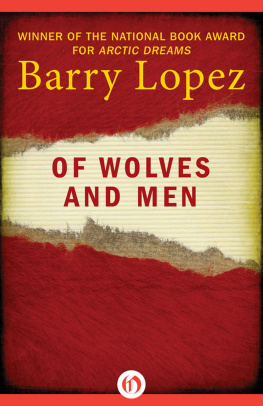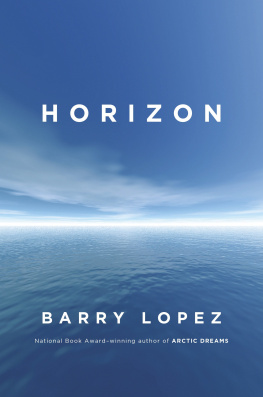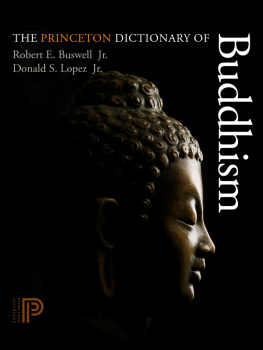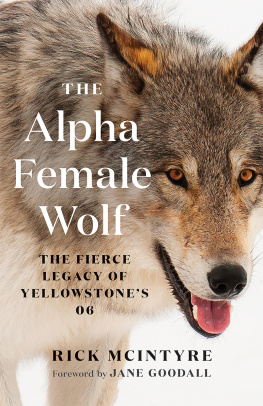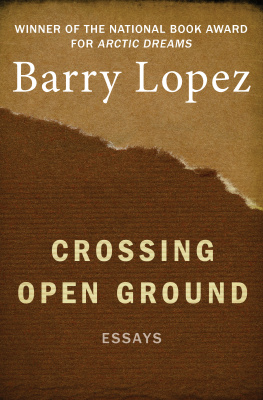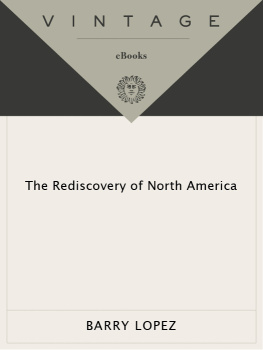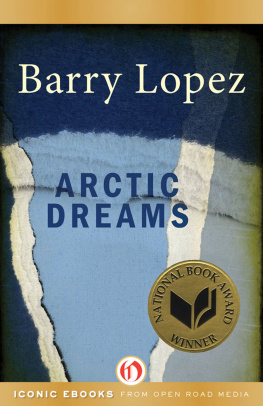
Of Wolves and Men
Barry Lopez
FOR WOLVES
Not the book, for which you would have little use,
but the effort at understanding.
I enjoyed your company.
We need another and a wiser and perhaps a more mystical concept of animals. Remote from universal nature, and living by complicated artifice, man in civilization surveys the creature through the glass of his knowledge and sees thereby a feather magnified and the whole image in distortion. We patronize them for their incompleteness, for their tragic fate of having taken form so far below ourselves. And therein we err, and greatly err. For the animal shall not be measured by man. In a world older and more complete than ours they move finished and complete, gifted with extensions of the senses we have lost or never attained, living by voices we shall never hear. They are not brethren, they are not underlings; they are other nations, caught with ourselves in the net of life and time, fellow prisoners of the splendour and travail of the earth.
HENRY BESTON, The Outermost House
Presumption is our natural and original disease. The most wretched and frail of all creatures is man, and withal the proudest. He feels and sees himself lodged here in the dirt and filth of the world, nailed and riveted to the worst and deadest part of the universe, in the lowest story of the house, trapped worse than bird or fish, and yet in his imagination he places himself above the circle of the moon, bringing heaven under his feet.
By the vanity of the same imagination be equals himself to God, attributes to himself divine faculties, and withdraws and separates himself from all other creatures; he allots to these, his fellows and companions, the portion of faculties and power which he himself thinks fit.
How does he know, by the strength of his understanding, the secret and internal motions of animals, and from what comparison between them and us does he conclude the stupidity he attributes to them?
MONTAIGNE, The Defense of Raymond Sebond
The only real revolutionary stance is that nature is the greatest convention of all. Perhaps there are no natures, no essencesonly categories and paradigms that human beings mentally and politically impose on the flux of experience in order to produce illusions of certainty, definiteness, distinction, hierarchy. Apparently, human beings do not like a Heraclitan world; they want fixed points of reference in order not to fall into vertigo, nausea. Perhaps the idea of nature or essence is mans ultimate grasp for eternity. The full impact of the theory of evolution (the mutability of speciesincluding man) is thus still to come.
JOHN RODMAN, The Dolphin Papers
INTRODUCTION
I AM IN A SMALL cabin outside Fairbanks, Alaska, as I write these words. The cold sits down like iron here, and the long hours of winter darkness cause us to leave a light on most of the day. Outside, at thirty below, wood for the stove literally pops apart at the touch of the ax. I can see out across the short timber of the taiga when I am out there in the gray daylight.
Go out there.
Traveling for hours cross-country you see only a few animal tracks. Perhaps a single ptarmigan or a hare. Once in a while the tracks of a moose. In the dead of winter hardly anything moves. Its very hard to make a living. Yet the wolf eats. He hunts in the darkness. And stays warm. He gets on out there.
The cabin where I am writing sits a few miles north of the city, in Goldstream Valley. This valley came briefly into the news a few years ago when wolves killed a lot of domestic dogs here. Goldstream Valley is lightly settled and lies on the edge of active wolf range, and that winter wolves got into the habit of visiting homes and killing pet dogs. A dog owner wouldnt hear a sound but the barking and growling of his dog. Then silence. He would pass a flashlight beam through the darkness and see nothing. In the morning he would find the dogs collar or a few of its bones stripped of meat. The wolves would have left behind little else but their enormous footprints in the snow.
After the wolves killed about twenty dogs like this, a petition turned up in local stores. Sign one sheet and it meant you wanted the Alaska Department of Fish and Game to kill the wolves. Sign another and it meant you didnt. The plan was defeated, five to one, and the Department of Fish and Game, for its part, declined to get involved. Some residents set out poisoned meat and steel traps on their own. The wolves went on killing dogs until spring, when the toll was something like forty-two.
When it was over some biologists, pressed for an explanation, told residents it had been a hard winter, that wolves had simply turned to dogs for food. Athabascan Indians living in Fairbanks said with a grin that that might be truethey didnt knowbut wolves just naturally hate dogs, and thats all it had been about. The owner of a sled-dog team argued that the wolf was a born killer, like the wolverine and the weasel. Some creatures God put on earth to help man, he said, and others to hinder him, and the wolf was a hinderer.
The dog-killing incident in Goldstream Valley brings together the principal threads in this book. What wolves do excites men and precipitates strong emotions, especially if men feel their lives or the lives of their domestic animals are threatened. Explanations for the wolfs behavior are rampant. Biologists turn to data. Eskimos and Indians accept natural explanations but also take a wider view, that some things are inexplicable except through the metaphorical language of legend. The owner of a dog team is more righteously concerned with the safety of his animals than with understanding what motivates wolves. And everyone believes to some degree that wolves howl at the moon, or weigh two hundred pounds, or travel in packs of fifty, or are driven crazy by the smell of blood.
None of this is true. The truth is we know little about the wolf. What we know a good deal more about is what we imagine the wolf to be.
Alaska is the last North American stronghold of the wolf. With Eskimos and Indians here, with field biologists working on wolf studies, with a suburban population in Fairbanks wary of wolves on winter nights, with environmentalists pushing for protection, there is a great mix of opinion. The astounding thing is that, in large part, it is only opinion. Even biologists acknowledge that there are things about wolves and wolf behavior you just have to guess at.
Lets say there are 8,000 wolves in Alaska. Multiplying by 365, thats about 3 million wolf-days of activity a year. Researchers may see something like 75 different wolves over a period of 25 or 30 hours. Thats about 90 wolf-days. Observed behavior amounts to about three one-thousandths of 1 percent of wolf behavior. The deductions made from such observations represent good guesses, and indicate how incomplete is our sense of worlds outside our own.
Wolves are extraordinary animals. In the winter of 1976 an aerial hunter surprised ten gray wolves traveling on a ridge in the Alaska Range. There was nowhere for the animals to escape to and the gunner shot nine quickly. The tenth had broken for the tip of a spur running off the ridge. The hunter knew the spur ended at an abrupt vertical drop of about three hundred feet and he followed, curious to see what the wolf would do. Without hesitation the wolf sailed off the spur, fell the three hundred feet into a snowbank, and came up running in an explosion of powder.
Next page
